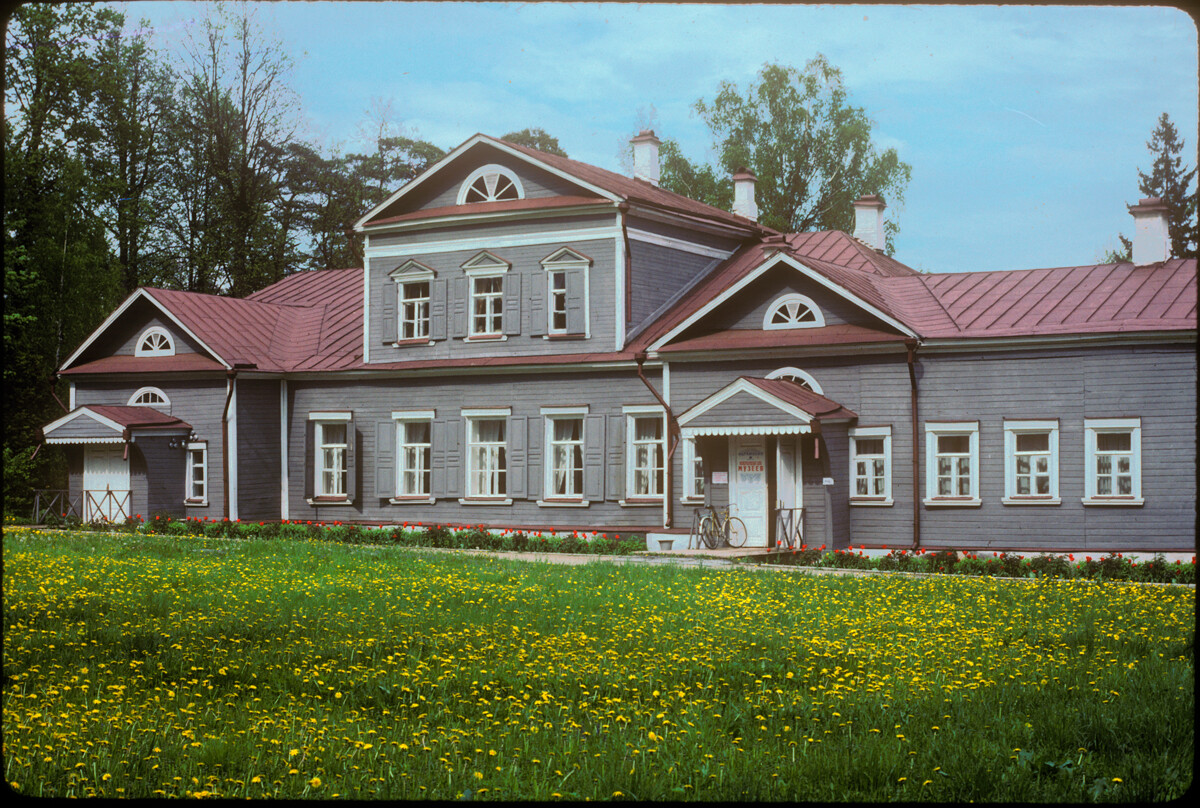
Abramtsevo. Estate house, courtyard facade. May 18, 1990
William BrumfieldAt the beginning of the 20th century, Russian chemist and photographer Sergey Prokudin-Gorsky developed a complex process for vivid, detailed color photography. His vision of photography as a form of education and enlightenment was demonstrated with special clarity through his photographs of historic sites throughout the Russian empire.
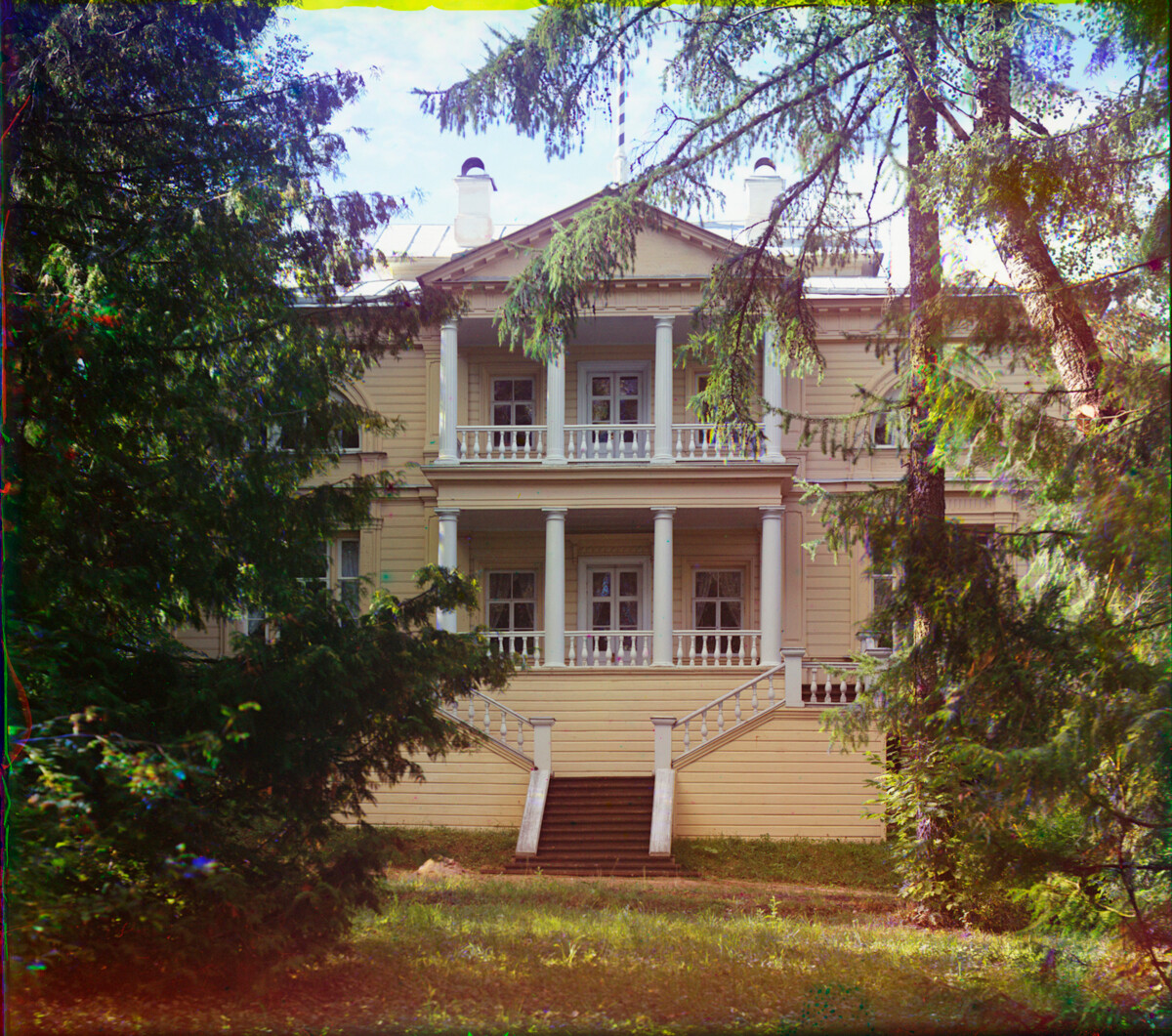
Borodino. Imperial palace. Summer 1911
Sergey Prokudin-GorskyOne such place is the village of Borodino, which Prokudin-Gorsky visited in the Summer of 1911, as part of a project to document sites connected with the centennial of the Napoleonic invasion of Russia.
Borodino is best known from Leo Tolstoy’s incomparable description in his novel ‘War and Peace’. The battlefield at Borodino has been preserved as a national shrine, where the Russian and French armies clashed on September 7, 1812, in an epochal struggle before the gates of Moscow.
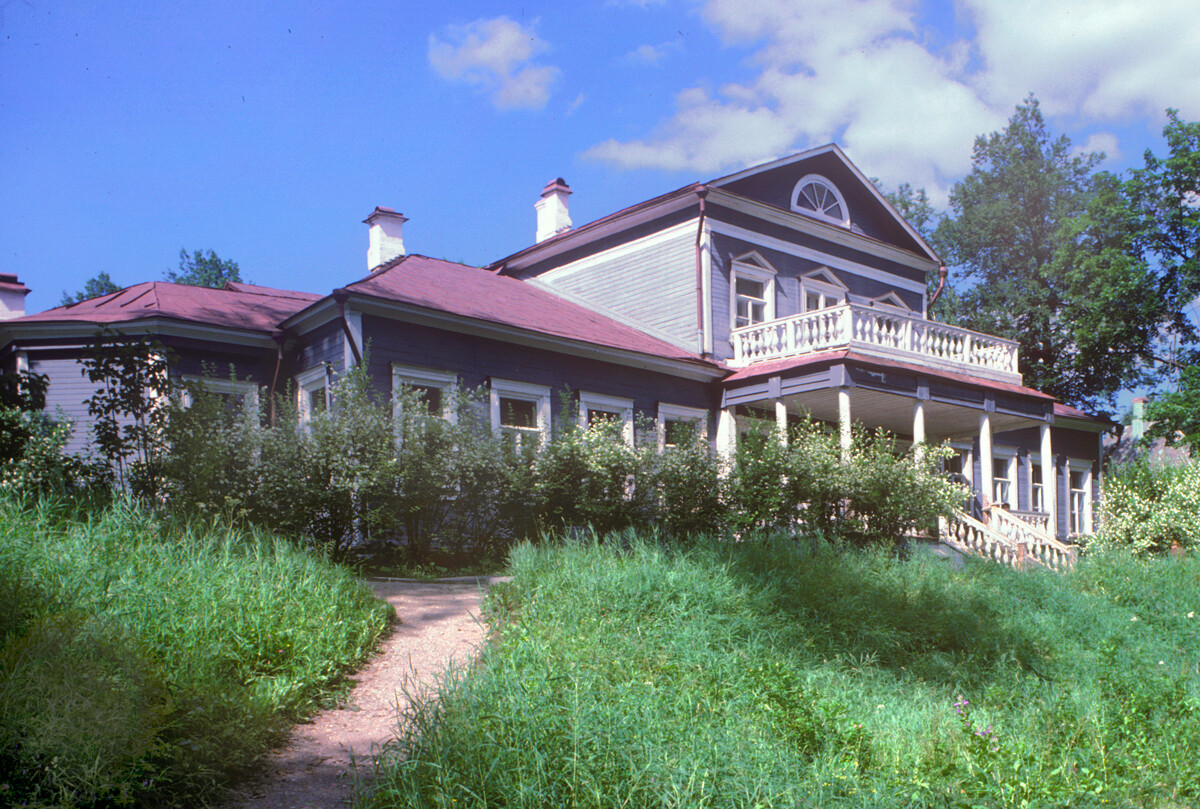
Abramtsevo estate. Estate house, park facade. June 28, 1995
William BrumfieldAt Borodino, Prokudin-Gorsky photographed not only sites associated with the battle, but also architectural monuments, such as the wooden Imperial Palace, built in 1838 to accommodate the imperial suite for the 25th anniversary of the battle in 1839. Despite the name ‘palace’, its dimensions and form were similar to early 19th-century wooden estate houses in the Russian heartland.
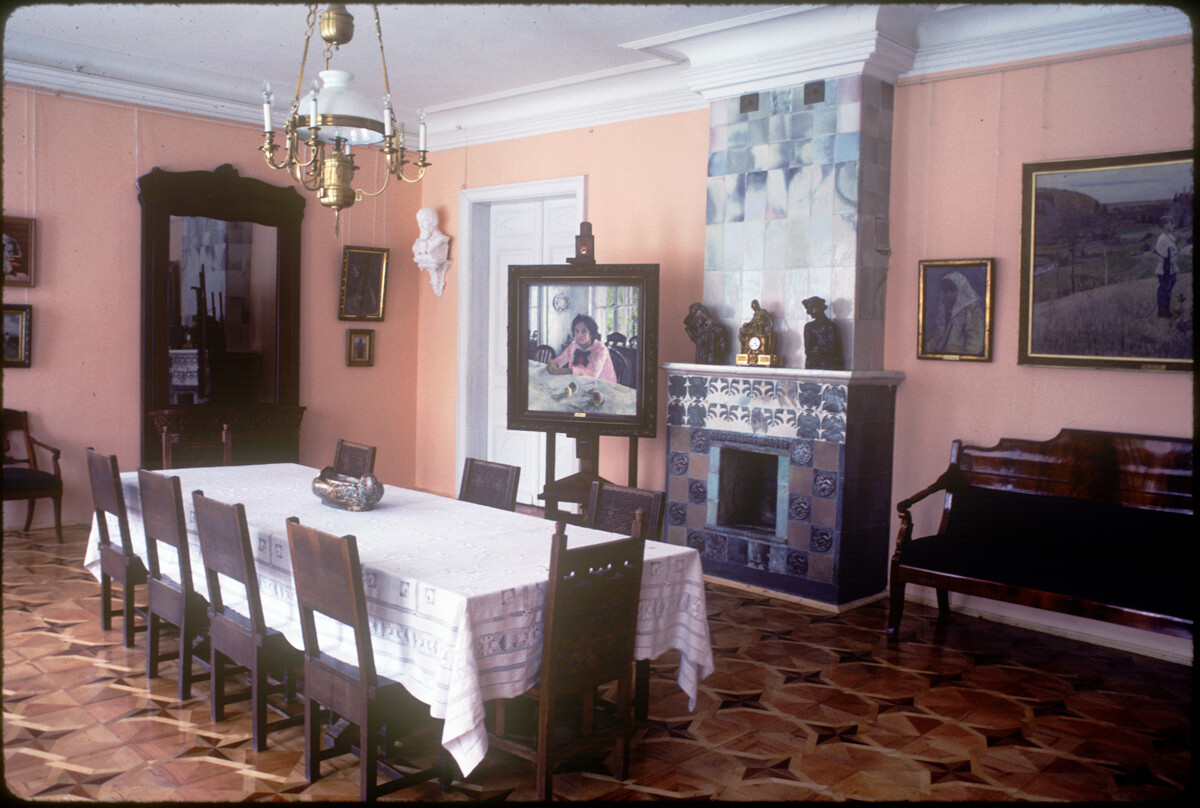
Abramtsevo. Estate house, dining room with ceramic tile stove & copy of Valentin Serov's portrait of Vera Mamontov. March 25, 1984
William BrumfieldAmong surviving country estates in the Moscow region, perhaps the most famous is Abramtsevo, located some 50 km northeast of Moscow on the way to Sergiev Posad. Abramtsevo is known for the beauty of its forest setting and its deep connections with Russian culture.
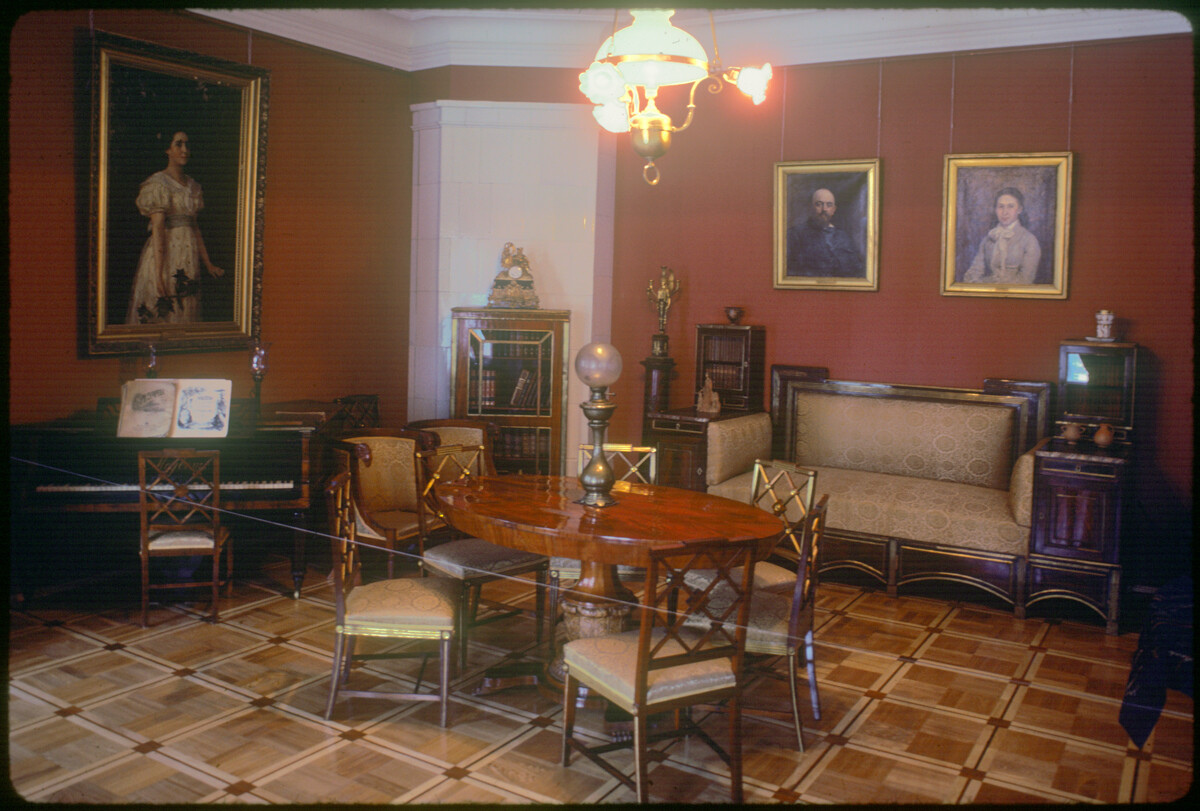
Abramtsevo. Estate house, drawing room with portraits of Savva & Elizaveta Mamontov by Ilya Repin. March 25, 1984
William BrumfieldAlthough inhabited as early as the 17th century, its intellectual significance dates from 1843, when the estate was acquired by Sergei Aksakov (1791-1859), a leading figure in an intellectual group known as the Slavophiles. During the mid-19th century, Aksakov’s legendary hospitality was extended to several cultural luminaries, including writers Nikolai Gogol and Ivan Turgenev.
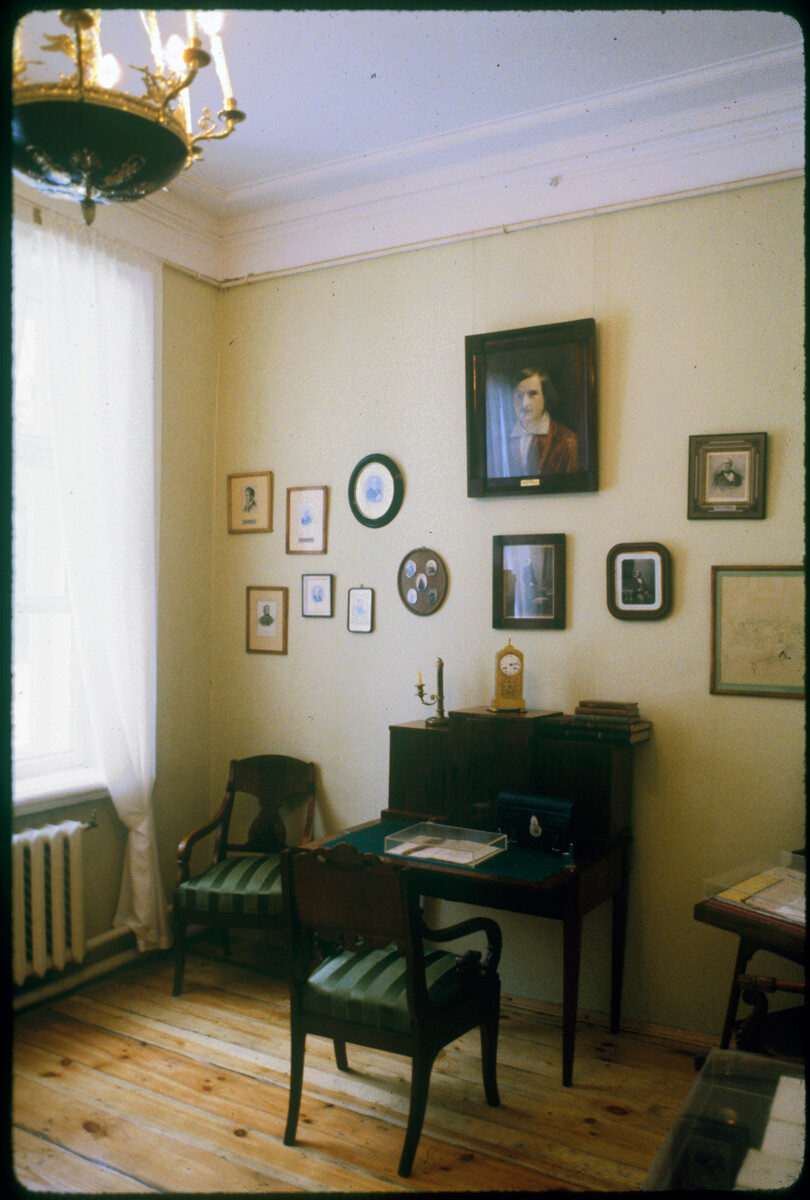
Abramtsevo. Estate house, study of the writer Nikolay Gogol. March 25, 1984
William BrumfieldThe main house, a long log structure covered with plank siding, has preserved its general form much as Aksakov acquired it. The interior, however, has many displays devoted to the next phase in the life of the estate.
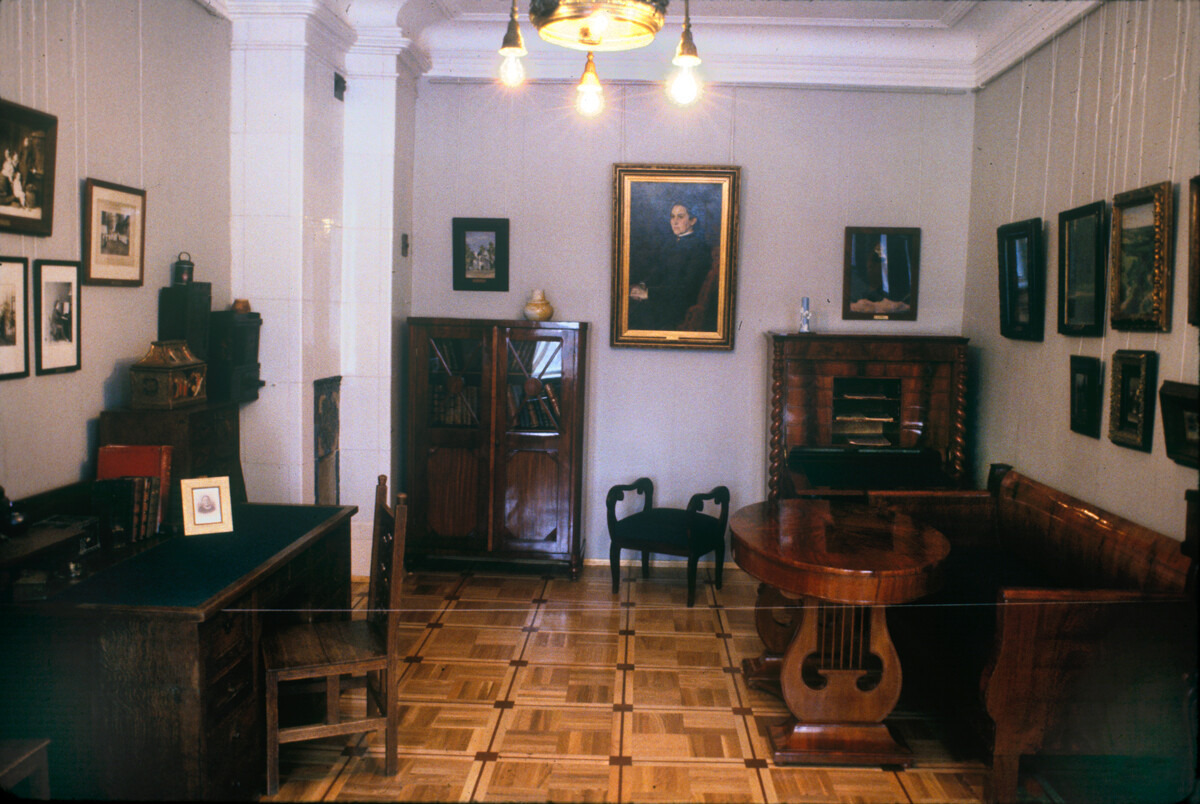
Abramtsevo. Estate house, study with portrait of Elizaveta Mamontov by Viktor Vasnetsov. March 25, 1984
William BrumfieldIn 1870, Abramtsevo was sold to Savva Mamontov (1841-1918), son of a pioneering Moscow industrialist named Ivan Mamontov. Like his father, Savva became a leading developer of Russian railroads, but he also discovered an interest in the arts and in traditional Russian culture.
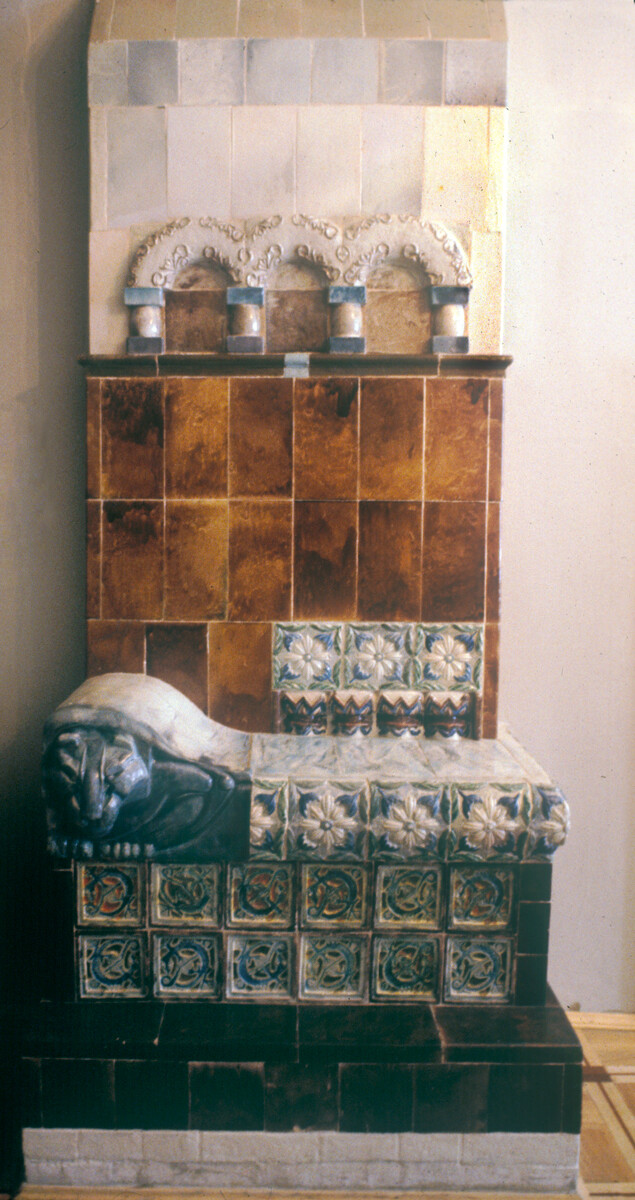
Abramtsevo. Estate house, hall, ceramic stove with ledge designed by Mikhail Vrubel in 1890 for mansion in Moscow. March 25, 1984
William BrumfieldWith the purchase of Abramtsevo, then in dilapidated condition, Mamontov and his wife Elizabeth, descendent of the Sapozhnikov silk and fabrics dynasty, not only had a bucolic retreat from Moscow, but also a setting in which they could gather a group dedicated to the revival of the arts and crafts.
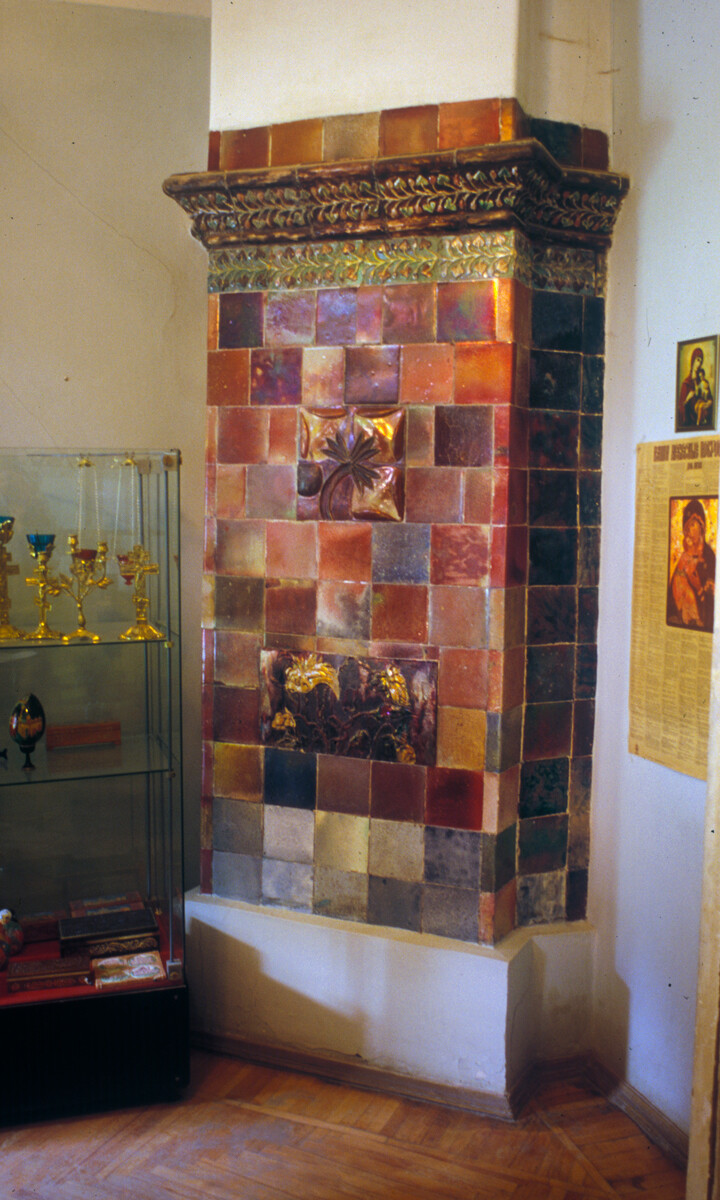
Abramtsevo. Estate house, vestibule, ceramic stove with free-form glazing designed by Mikhail Vrubel & made at Abramtsevo ceramic workshop. July 8, 1994
William BrumfieldAlthough Abramtsevo would be rivaled by the artistic center at the Talashkino estate of Princess Maria Tenisheva, Mamontov's group was unique in its breadth of artistic interests and its influence on architecture and design at the turn of the century.
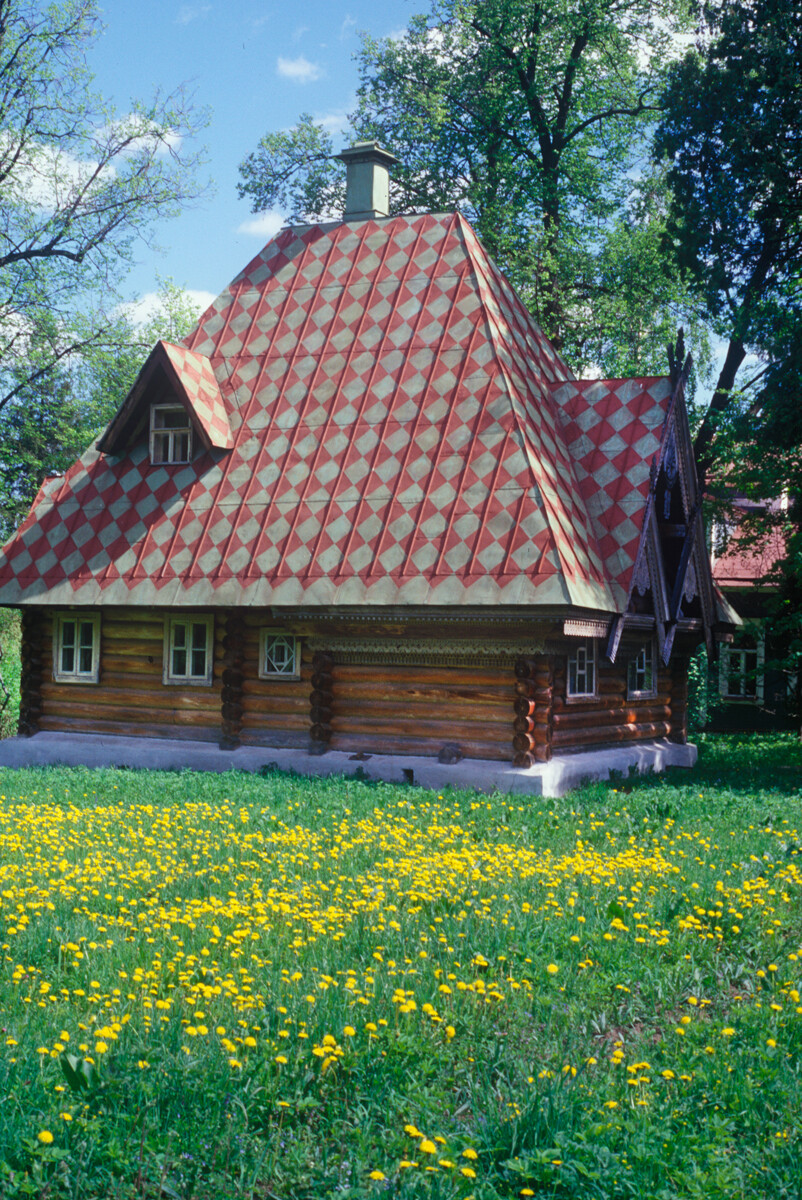
Abramtsevo. "Teremok" bathhouse. May 29, 1999
William BrumfieldAmong the first artists to work at Abramtsevo in the early 1870s were Viktor Hartmann and Ivan Ropet, leading proponents of the “Russian Revival” style in architectural design. Before his death in 1873, Hartmann built the Abramtsevo studio with richly carved wooden decorations typical of the crafts revival.
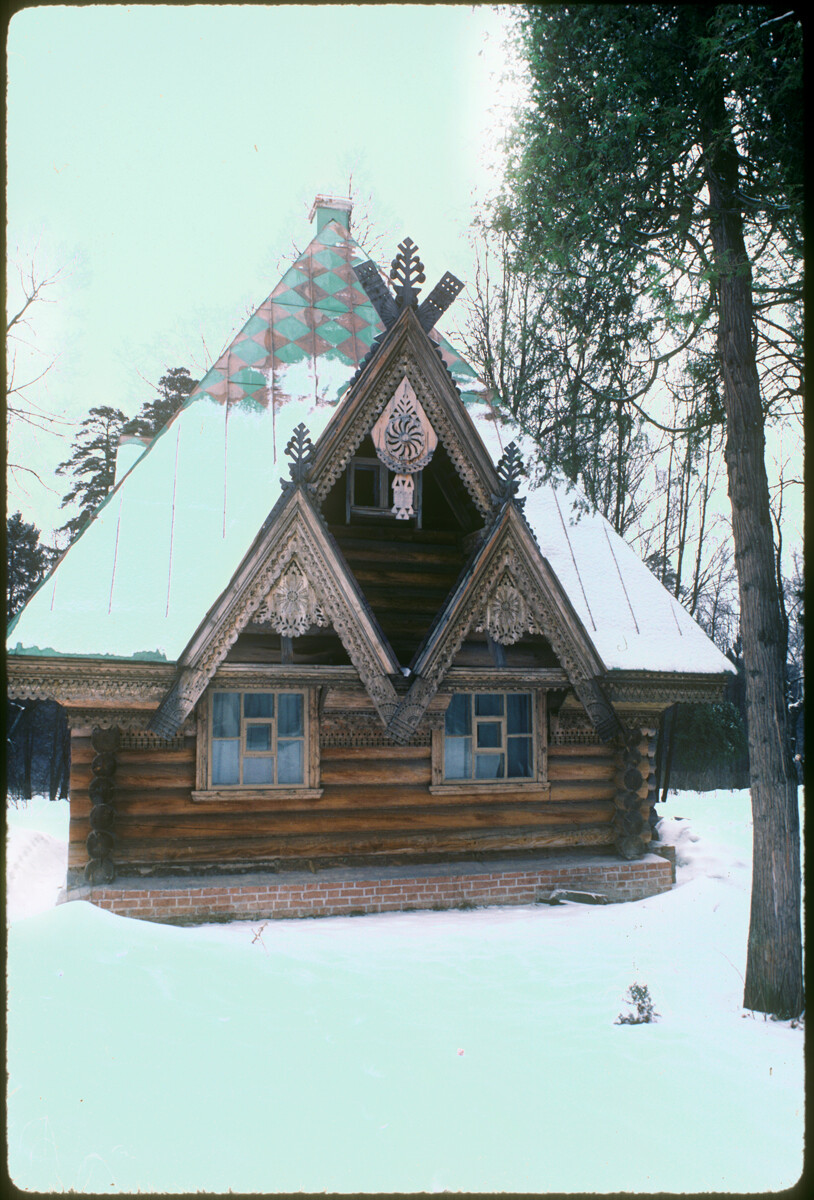
Abramtsevo. "Teremok" bathhouse. March 25, 1984
William BrumfieldToday, the studio serves as a museum of the innovative ceramic designs created at Abramtsevo. Nearby is the Ropet's log “teremok” bathhouse, which united under a steep roof asymmetrical decorative components that would become a feature of innovative architecture at the turn of the 20th century.
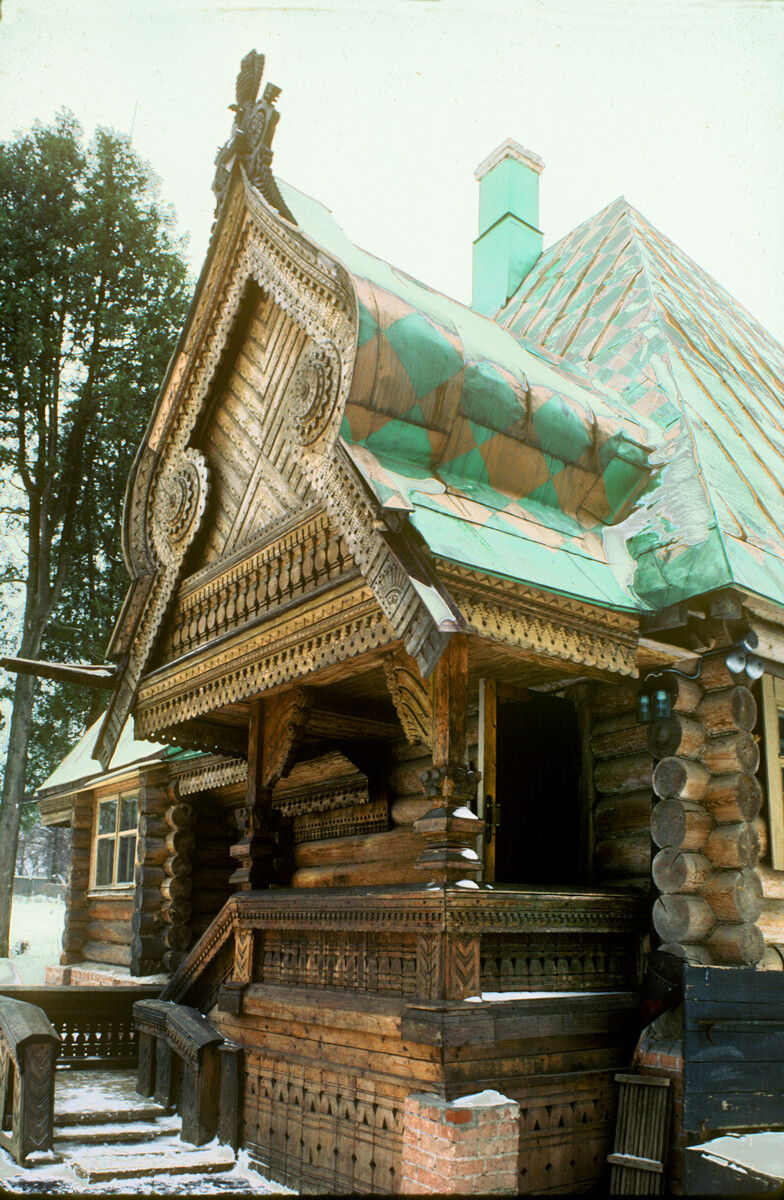
Abramtsevo. "Teremok" bathhouse, entrance porch. March 25, 1984
William BrumfieldOne of the most active participants of the Abramtsevo group was Elena Polenova (1850-1898), sister of painter Vasily Polenov. In 1882, she established the furniture and woodworking shop, which used peasant crafts traditions and encouraged the continuation of those traditions in the education of village children.
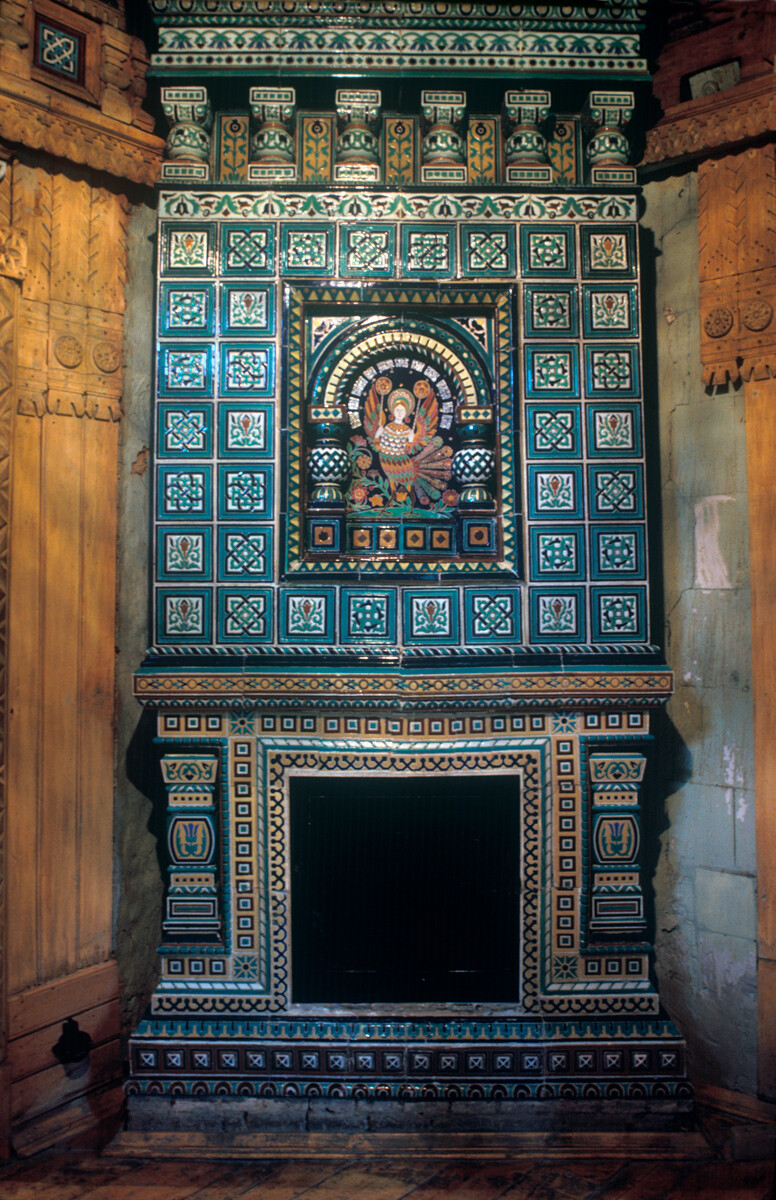
Abramtsevo. "Teremok" bathhouse, ceramic stove by Leopold Bonafede. May 18, 1990
William BrumfieldPolenova’s most productive enterprise, however, was the ceramics workshop, which started modestly, but, after 1889, became a remarkable force in design and architecture in Moscow. For example, Polenova was able to draw on the talent of the visionary artist Mikhail Vrubel, whose ceramic designs are preserved in tile stoves inside the estate house at Abramtsevo, as well as in the Hartmann studio.
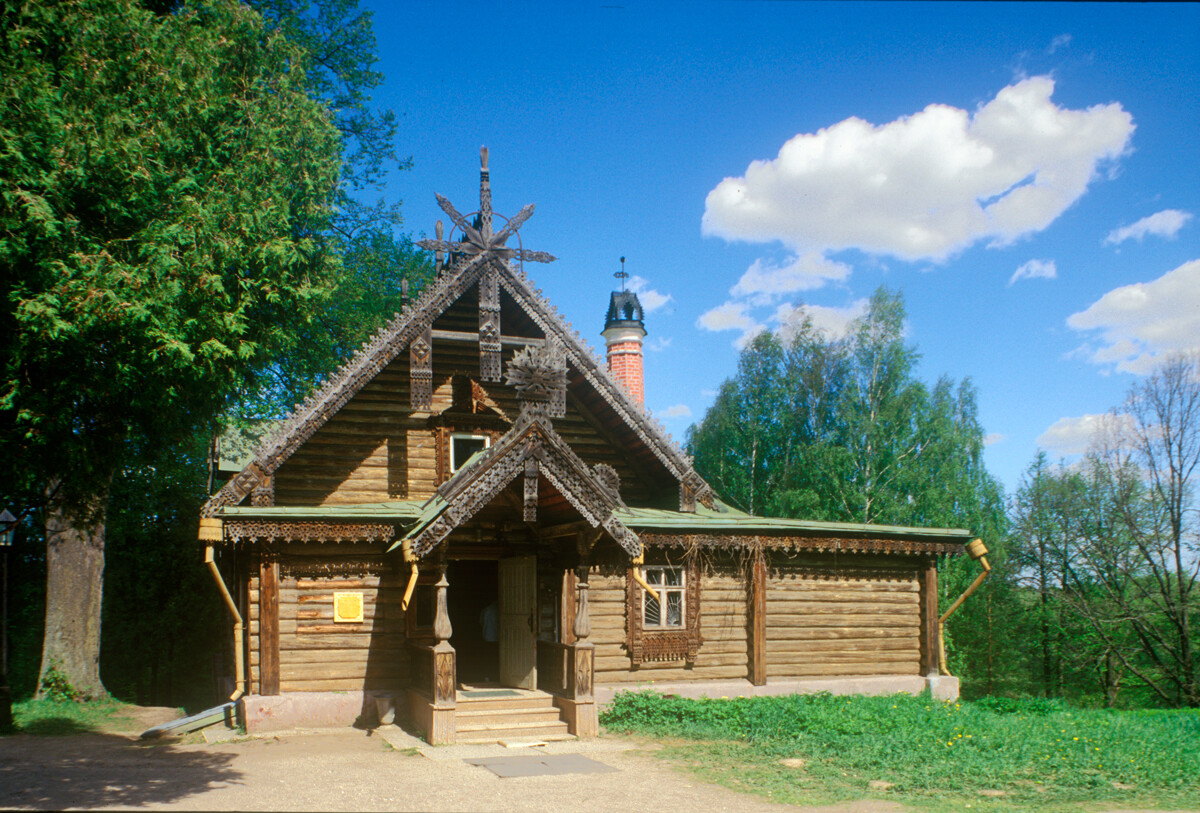
Abramtsevo. Ceramics studio. May 25, 1999
William BrumfieldNearby under a glass canopy is a ceramic bench in which Vrubel combined mythic motifs in a fantasy design.
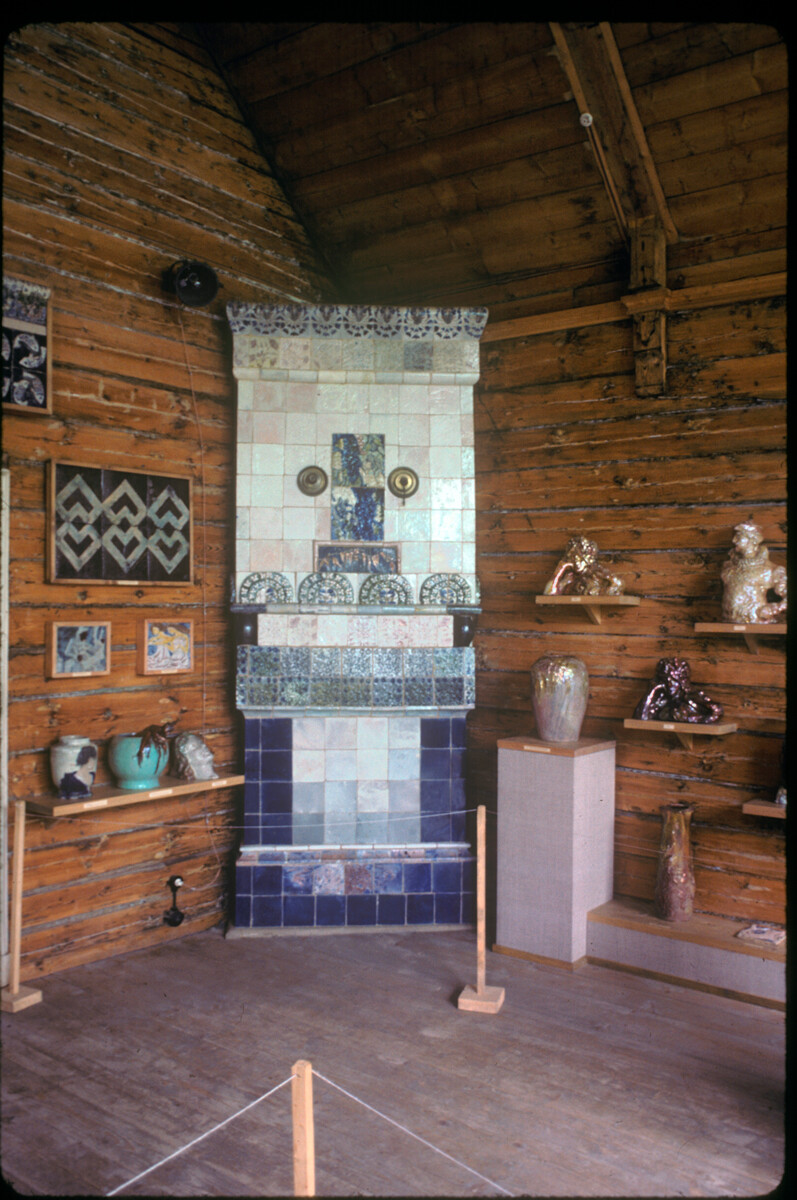
Abramtsevo. Ceramics studio. Interior with ceramic stove designed by Mikhail Vrubel. May 18, 1990
William BrumfieldThese varied creative elements came together in the design and construction of a small church at Abramtsevo estate. Although the Khotkov Monastery was less than two miles away, frequent floods around Easter convinced Mamontov to build a church on the estate grounds.
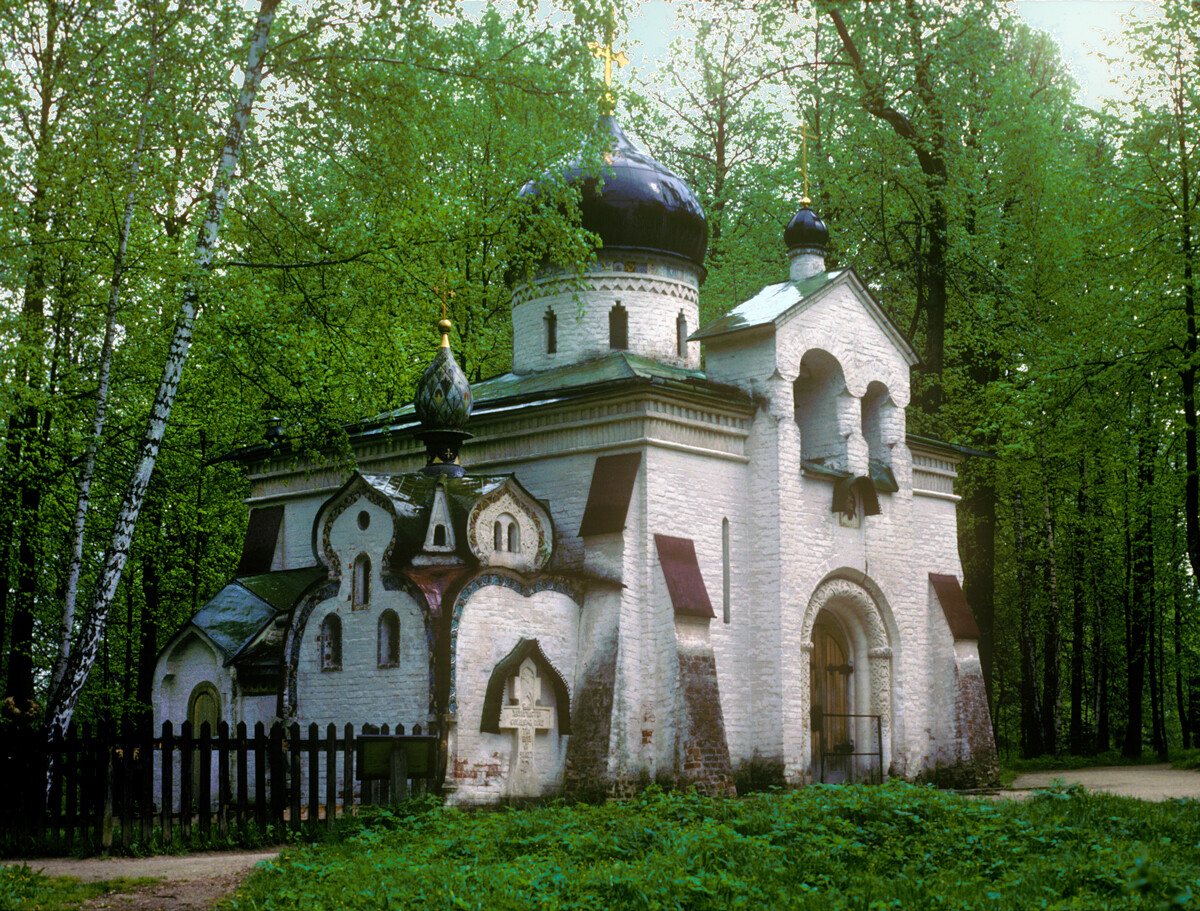
Abramtsevo. Church of the Miraculous Icon of the Savior, northwest view with Mamontov burial chapel. May 18, 1990
William BrumfieldThe communal effort in building the church, dedicated to the Icon of the Savior "not created by hand", has become legendary in Russian art history – the realization of an artistic synthesis by a group dedicated to preserving art in the spiritual life of the people. Indeed, the church was an “amateur” production, unconstrained by committees, academic rules or complex engineering methods.
Initial sketches by Vasily Polenov for the church design drew on the architecture of early medieval Novgorod. Other elements, including those of 12th-century Vladimir were incorporated into painter Viktor Vasnetsov's reworking of the design into an architectural project, architecture that emphasized structural clarity and the relation between material and form.
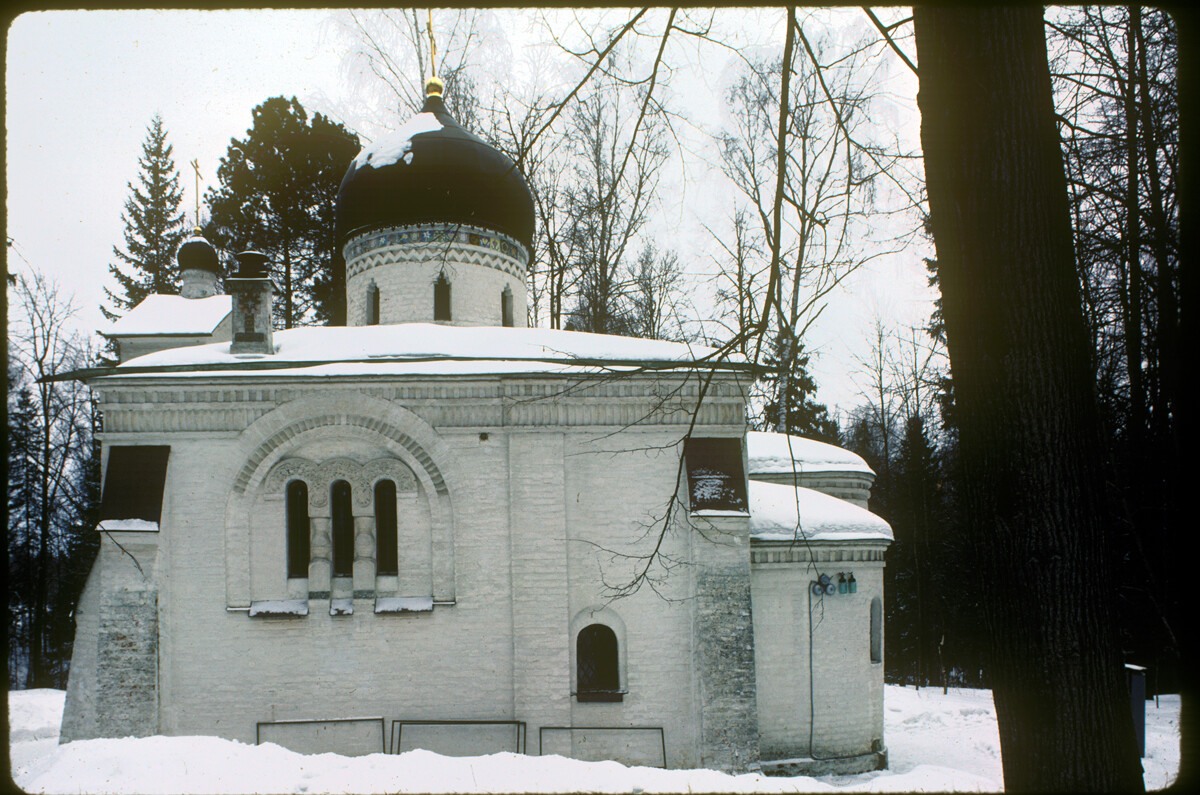
Abramtsevo. Church of the Miraculous Icon of the Savior, south view. March 25, 1984
William BrumfieldVasnetsov, a painter of historical and semi mythical subjects from the Russian past, integrated these elements into a small jewel of a structure, constructed in 1881–1882 with exaggerated contours and a large curved segmented window on the south wall.
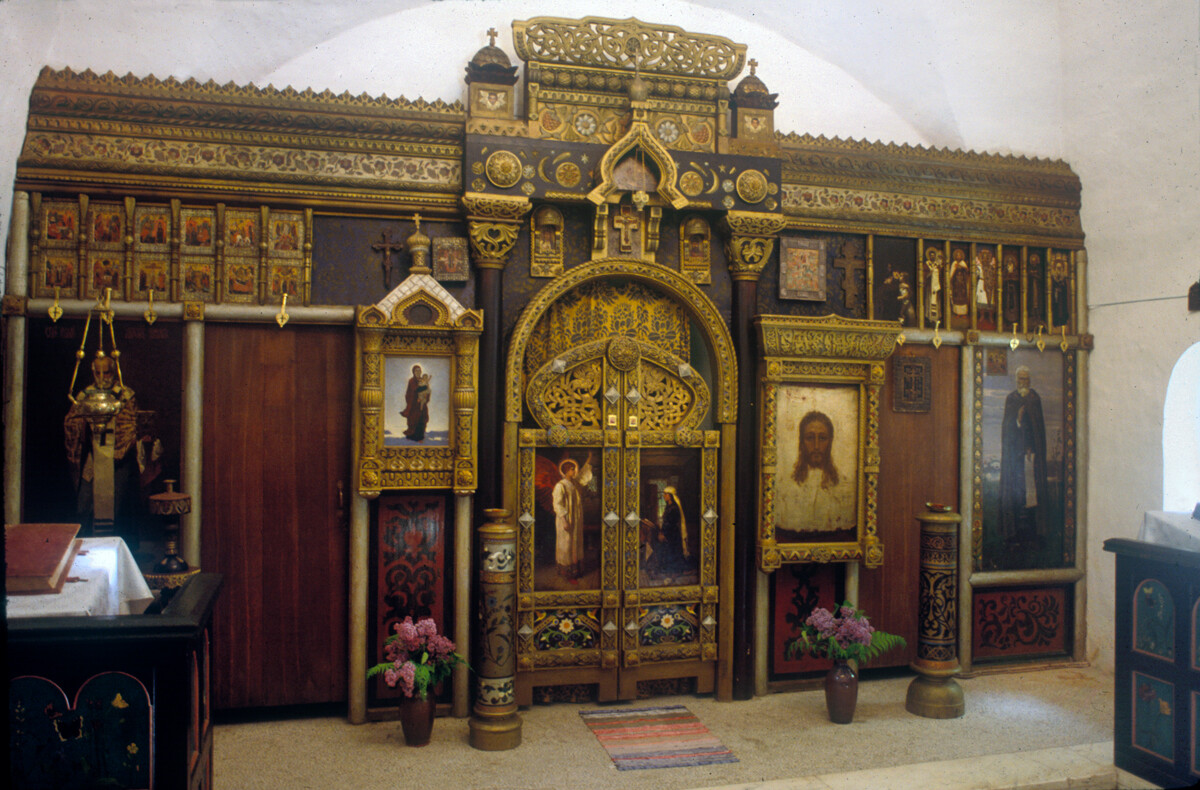
Abramtsevo. Church of the Miraculous Icon of the Savior. Icon screen with work by Viktor Vasnetsov, Dmitry Polenov & others. June 3 1992
William BrumfieldThe decoration of the interior and the design of the furnishings involved not only Polenov and Vasnetsov but also the painters Ilia Repin and Apollonary Vasnetsov (Viktor's brother), the sculptor Mark Antokolsky and Elizabeth Mamontova, who participated actively in the Abramtsevo crafts circle. The communal spirit at Abramtsevo transcended professional divisions in the search for aesthetic harmony.
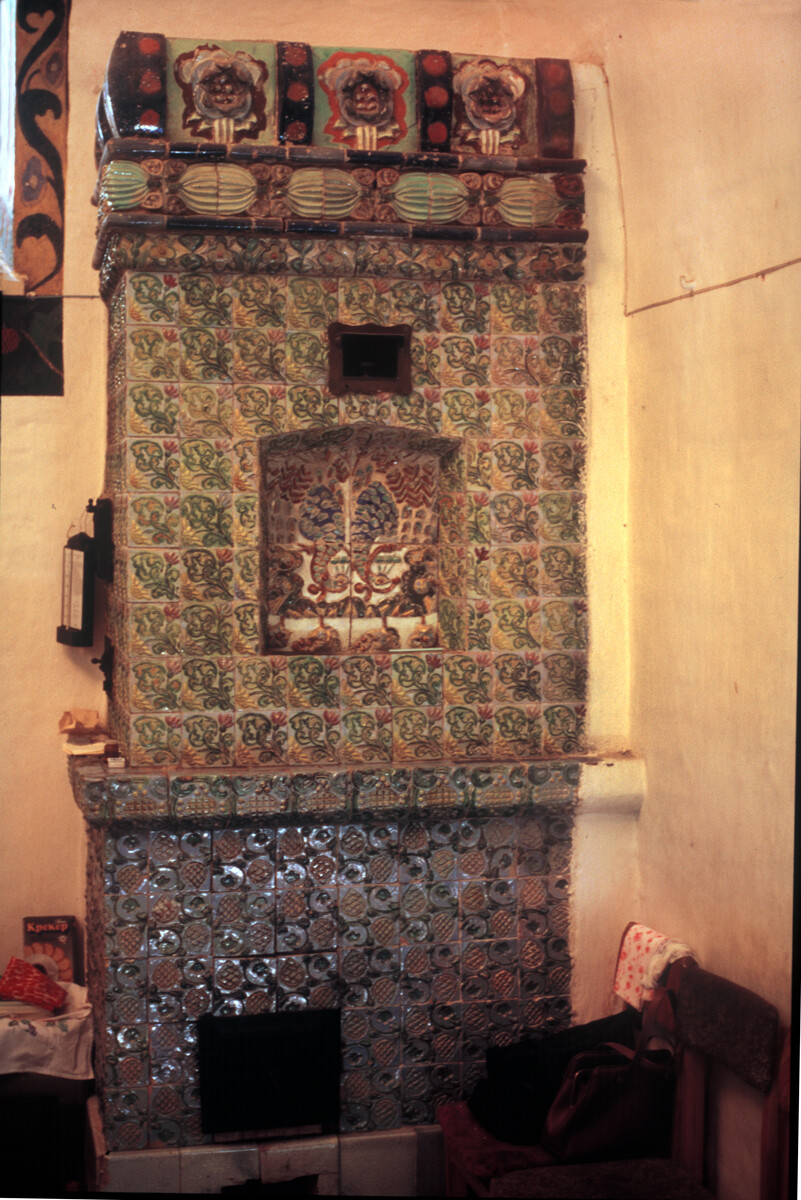
Abramtsevo. Church of the Miraculous Icon of the Savior. Ceramic stove designed by Mikhail Vrubel. July 8, 1994
William BrumfieldThe Abramtsevo workshops were part of that unity, with each craft contributing to the furnishings and decoration of the Savior Church. Especially notable are the ceramic tiles, both on the inside (on the traditional Russian stove) and the outside in ornamental strips beneath the cupola.
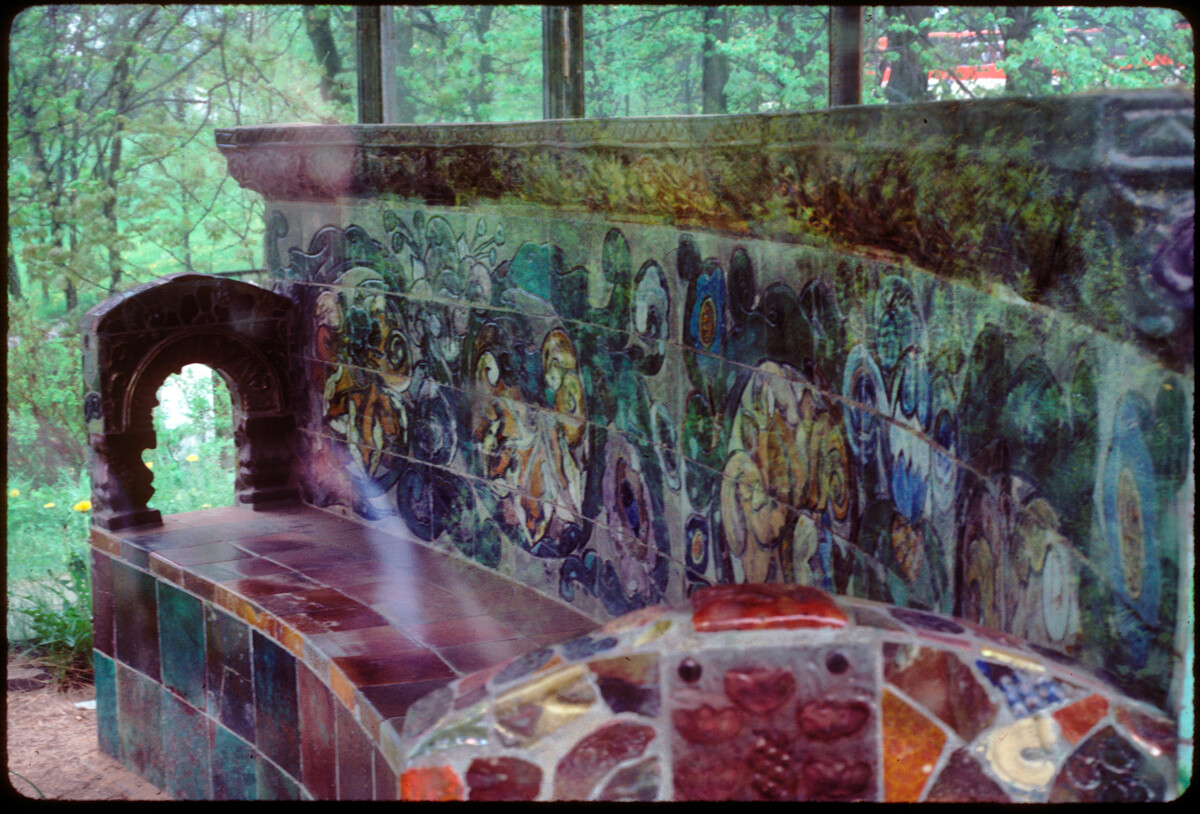
Abramtsevo. Park with ceramic bench designed by Mikhail Vrubel. May 18, 1990
William BrumfieldTen years after the church was completed, Vasnetsov added a burial chapel on the north facade, where, in 1892, Mamontov's invalid son Andrei was buried. In 1918, Savva Mamontov was buried in the same chapel. This addition was also exquisitely decorated with Abramtsevo tiles.
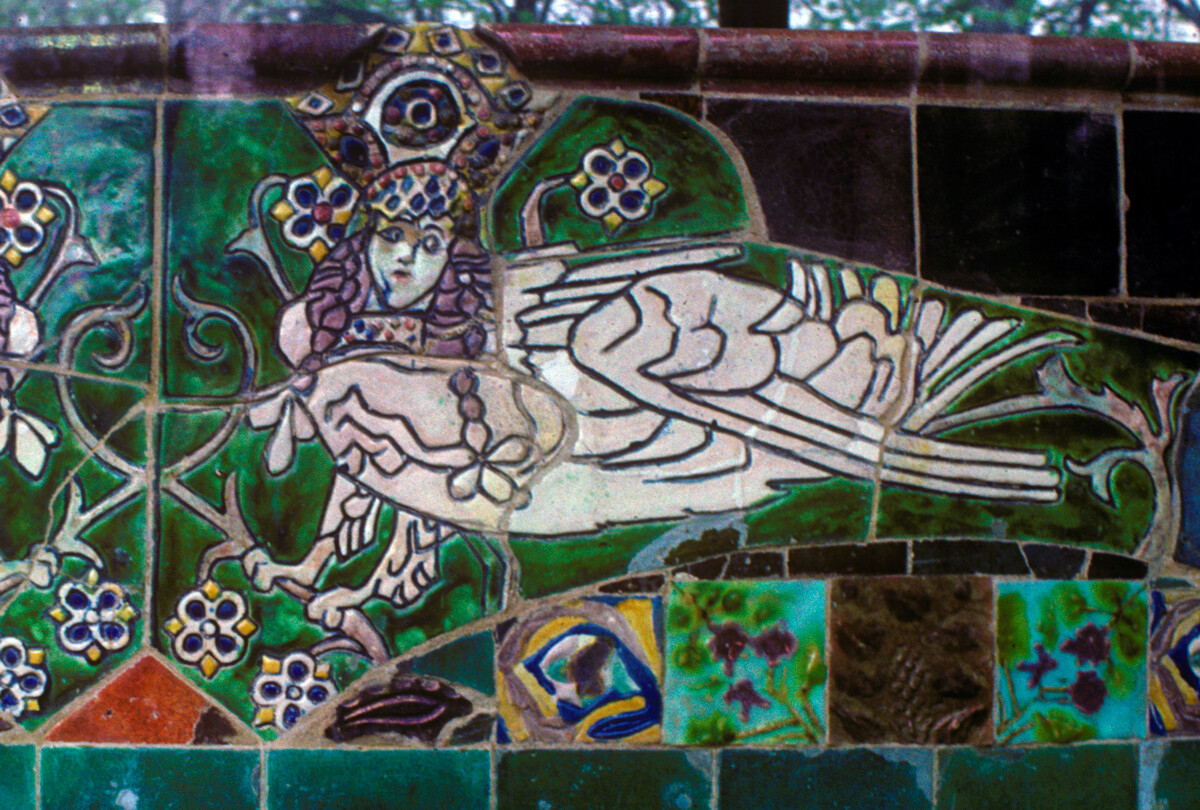
Abramtsevo. Park with ceramic bench designed by Mikhail Vrubel. Detail of fantastical "Sirin" bird. May 18, 1990
William BrumfieldThe Savior Church, with its inspired union of structure, function and material, was a pioneering expression of the link between tradition and modernity in Russian architecture.
In addition to the central buildings surveyed above, the park includes architectural fantasies such as the ‘Hut on Hen’s Legs’, created by Viktor Vasnetsov in 1883, as well as the Polenov dacha. All of this is set within an idyllic forest landscape overlooking the small Vorya River.
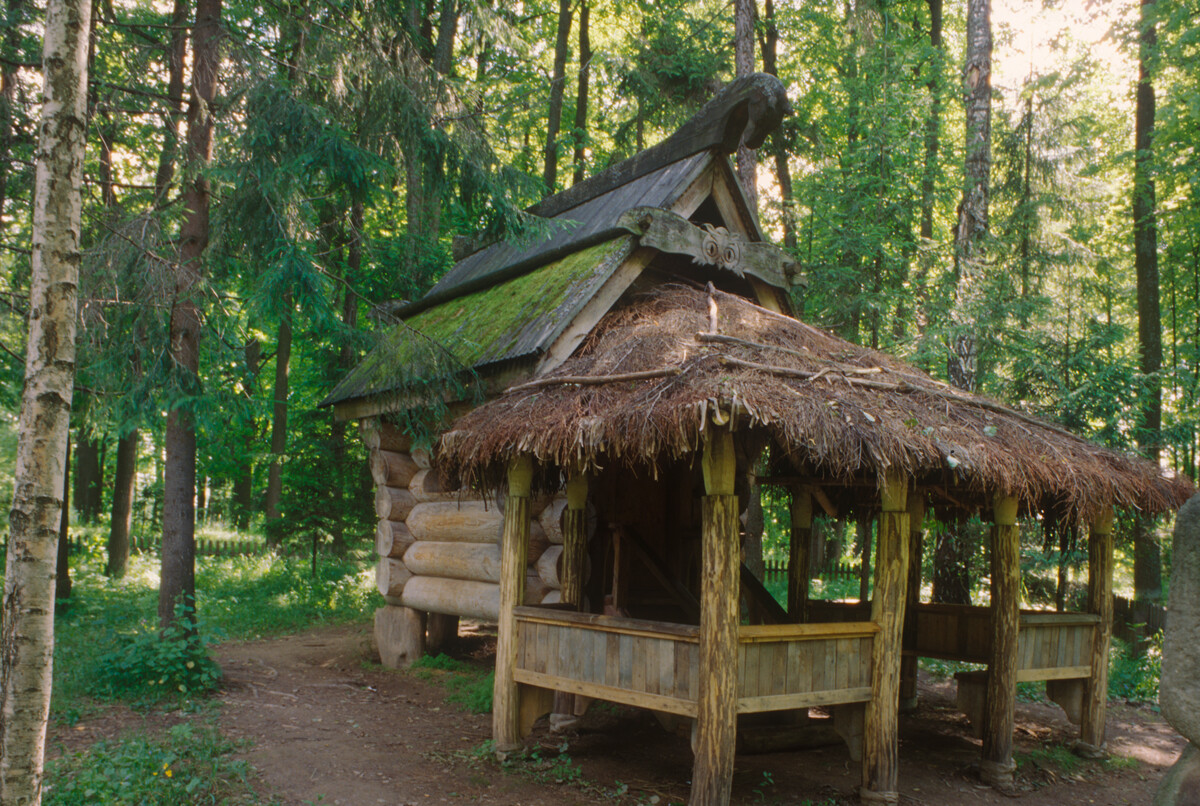
Abramtsevo. Park with "Hut on Hen's Legs". July 8, 1994
William BrumfieldThe creativity of the Abramtsevo community reflected a broader cultural tendency that emphasized both the aesthetic and spiritual realms. This cultural revival stimulated an interrelation between the arts characteristic of so many of Abramtsevo’s activities – not simply the crafts, the visual arts and architecture, but also drama, music and set design.
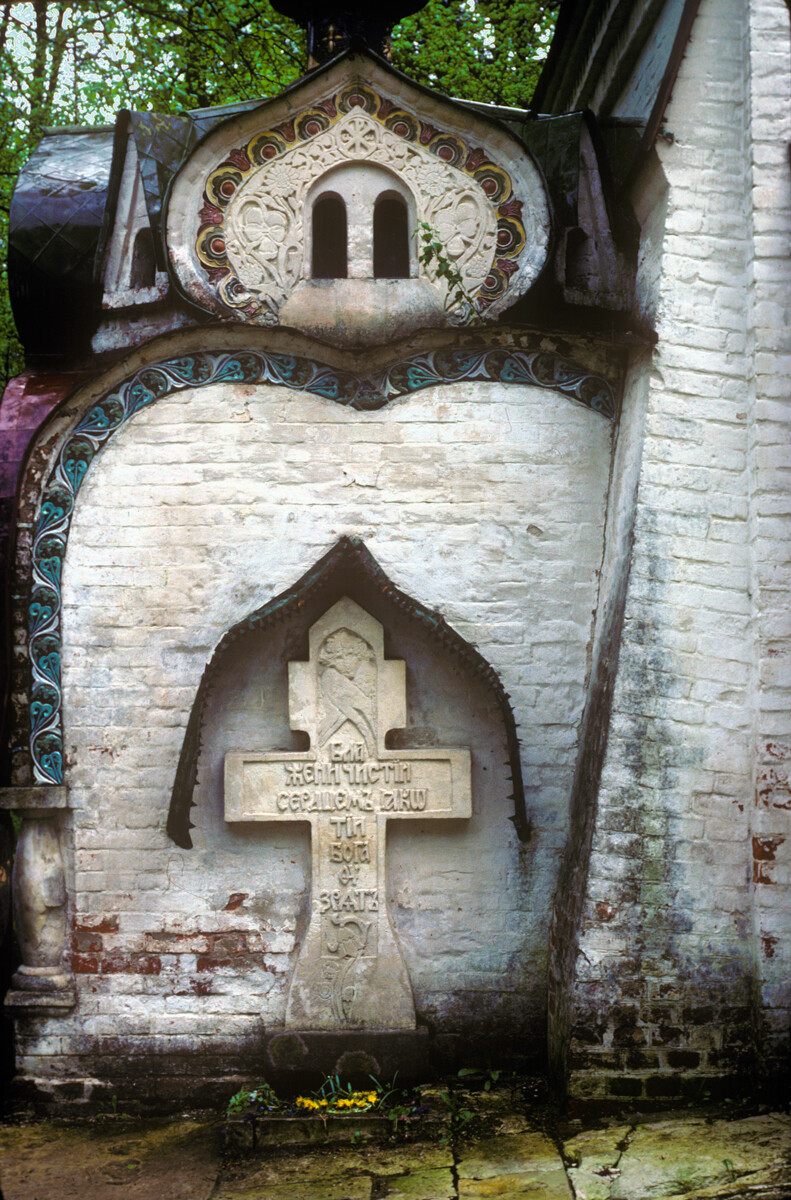
Abramtsevo. Church of the Miraculous Icon of the Savior, northwest corner with Mamontov burial chapel. May 18, 1990
William BrumfieldIn the early 20th century, Russian photographer Sergey Prokudin-Gorsky developed a complex process for color photography. Between 1903 and 1916, he traveled through the Russian Empire and took over 2,000 photographs with the process, which involved three exposures on a glass plate. In August 1918, he left Russia and ultimately resettled in France where he was reunited with a large part of his collection of glass negatives, as well as 13 albums of contact prints. After his death in Paris in 1944, his heirs sold the collection to the Library of Congress. In the early 21st century, the Library digitized the Prokudin-Gorsky Collection and made it freely available to the global public. A few Russian websites now have versions of the collection. In 1986, architectural historian and photographer William Brumfield organized the first exhibit of Prokudin-Gorsky photographs at the Library of Congress. Over a period of work in Russia beginning in 1970, Brumfield has photographed most of the sites visited by Prokudin-Gorsky. This series of articles juxtaposes Prokudin-Gorsky’s views of architectural monuments with photographs taken by Brumfield decades later.
If using any of Russia Beyond's content, partly or in full, always provide an active hyperlink to the original material.
Subscribe
to our newsletter!
Get the week's best stories straight to your inbox